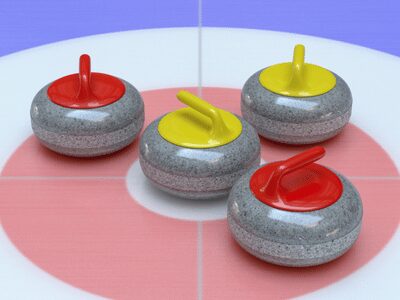Do Professional Curlers Get Paid?
Sliding stones across heavy sheets of ice may not seem like a professional, money-making sport. Still, it would probably surprise you how popular the sport is.
To the outsider, Curling is like darts and bowling — unless you are into the intricacies — your knowledge will be limited.
Like most sports, Curling has a professional league. But do professional curlers get paid, and are curlers professional?
While it’s not the NFL or the NBA, professional curlers get paid. The annual salary mainly depends on the player’s marketability — it can range from $50,000 to $140,000. Brad Jacobs currently earns the most at $138,500 a year.
Professional Curling is a niche sport. However, it’s most often broadcast to the most viewers during the Winter Olympics. But just because it gets the most fame every four years doesn’t mean there aren’t other avenues for the sport.

Why is Curling a niche sport?
There’s no explanation outside of the fact that other professional sports, such as the NFL, NBA, NASCAR, college football, and the NHL, are insanely popular with built-in fanbases worldwide.
The advertising revenue for all these professional sports is immense, and it would take an unlikely event of epic proportions to change that. Curling is a slower sport as well, which makes little sense as golf is a slower sport that also has a substantial following.
Most athletes turn to the more marketable sports’ more popular and money-making machines, substantially reducing the pool of athletes available for other sports. Not only is Curling not as popular in the states, but it’s also not as popular worldwide, with soccer being one of the most popular sports.
Unless the media suddenly decides to invest a significant amount of time and money into Curling — and there’s nothing to indicate that they ever would — Curling will remain a niche sport that’s popular amongst the few and far between.
How much does a professional curler make?
Technically there are no professional curlers. Of course, the word ‘technically’ is easy to interpret. There are plenty of players out there that are what anyone would rightly consider professionals.
Top 10 “Professional” Curlers
- Brad Jacobs: Canadian professional curler who makes $138,500/year
- Anna Hasselberg: Professional Swedish curler who makes $123,210/year
- Mike McEwen: Professional Canadian curler who makes $94,136/year
- Satsuki Fujisawa: Professional Japanese curler who makes $93,265/year
- Bruce Mouat: Professional Scottish curler who makes $79,122/year
- Tracy Fleury: Professional Canadian curler who makes $85,730/year
- Brad Gushue: Professional Canadian curler who makes $76,900/year
- Silvana Tirinzoni: Professional Swedish curler who makes $78,886
- John Epping: Professional Canadian curler who makes $71,900/year
- Kerri Einarson: Professional Canadian curler who makes $70,500/year
Those are the current top ten professional curlers in the world. They make a decent living by some standards, depending on where they live. They also earn additional income through advertising; however, that’s mostly during the Winter Olympics.
As you can see, it’s a technicality when discussing the professionalism of some curlers because certain ones make more than enough money to qualify the sport as a “living,” and anything you do for a living is considered a profession.
Most “professional” and Olympic curlers rely on sponsorship deals, but these are not as plentiful as in other sports.
Outside of the curling season and curlers often must turn to different careers. Even the money many professional curlers make is usually very slim in the end because much of that money goes towards funding the next season of Curling. Some curling teams spend as much as $150,000 yearly to travel to various curling events, which cuts deeply into their funds.
Professional Curling has a seasonal component. Most money is made during touring seasons. Many of what might be termed “professional” curlers have to work regular jobs during the offseason to make up for the difference.
However, many curlers will tell you that they simply love the sport and participate despite the lack of money. Fortunately, when curlers take time off from their regular jobs, they make plenty of money while engaging in the sport.
What events pay Curlers?
Curlers don’t just make money when they participate in the Winter Olympics. They also make yearly money by participating in several tours and events. For instance, there is the Field at the Brier in Canada.
The Field at the Brier
The Field at the Brier is a curling event held annually in Canada. It is one of the world’s most prestigious curling events and is considered the pinnacle of the sport.
The event is held in the province of Manitoba and is hosted by the Manitoba Curling Association.
The Field at the Brier is a 32-team event open to all Canadian curling Association curlers members. The event is held over ten days, and the winner is crowned the Brier Champion.
Curling events there draw much of the payout from government funding. At the end of certain events, the prize money can be well north of $200,000, which is usually distributed amongst the top placing players.
Sport Canada Curling Events
Sport Canada also supplies funding for the curling season and events throughout the country. However, it’s not funding at levels that players could depend on as yearly salaries. There is also the Pinty’s Grand Slam tour, which takes place over seven locations and games.
World Men’s Curling Championship and Tour
The prize money for winning the men’s world curling tour is $1.5 million. However, that total is spread out over the seven events so that no single player will make all that money at once. A single player would only win the total if they placed first in all seven events.
The World Curling Tour is another event that curlers can participate in. Participation alone is enough to earn roughly $1,500 per month, assuming you’re not placing first constantly. You have to win to make enough money to depend on the sport alone as a living.
It’s very rare for a single player to use nothing but Curling as a living, and most have a full-time jobs. However, players that win at the big events win a lot.
Without placing first, it’s hardly worth the money, but it can be a nice little bonus for those who place highly, if not in the first place.
The cost of participating
So far, we have discussed the payouts and the number of money players participating in Curling can make yearly. However, there is a cost to participate. Like many things in life, engaging in something you love isn’t free.
Depending on their level of play and where they are playing, some teams can spend upwards of $100k before winning anything, assuming they will win enough to make money back. Making enough to make your money back along with a profit is even more difficult.
Curlers often have to go hunting for sponsorships. It’s almost like freelancing. You must go out and cold pitch potential clients and hope they contact you back.
Chasing sponsorships involves the same thing, cold calling potential sponsors and attempting to talk them into the value of sponsoring them. It’s certainly not a sport that will make you rich overnight, and it’s not a sport that curlers ever approach with the understanding that they will make a ton of money.
So why do curlers participate?
Most curlers participate in Curling because they love the sport. It’s not a money-making assembly line. There are many reasons to enjoy Curling without the concern over money.
The sport is a blast to play — and it takes excellent precision to place the rock on the mark while sliding it over ice. There’s the joy of competition, which is often enough for many people.
At the Olympic level, it’s the challenge and the commitment to being the absolute best, being on world TV, competing with the best of the best, and having one of the most significant moments under the spotlight they are likely to have.
Where is Curling most popular in the US?
Curling is most prevalent in states with many winter sports enthusiasts, such as Minnesota, Wisconsin, and Michigan. Additionally, states with a substantial Scottish or Canadian influence, such as North Dakota and Maine, have higher popularity for the sport.
How much do curling stones weigh?
A curling stone — known as a “rock” — typically weighs between 38 and 44 pounds (17.2 and 19.9 kg). The weight of a curling stone is important because it affects how far the stone will travel. A heavier stone will travel a shorter distance than a lighter stone.
Where does curling stone come from?
Ailsa Craig an uninhabited island of about 240 acres about 10 miles offshore in the Firth of Clyde in Scotland.
A small island off the west coast of Scotland that once harbored pirates and Catholics and is now the source of granite used to make stones for the sport of Curling.
Around 60% of curling stones are made from Ailsa Craig granite, which is ‘harvested’ every few years by Kays of Scotland. The Kays have held exclusive rights since 1851. The other 40% of stones come from the Trefor granite quarry in Wales.
Ailsa Craig (Gaelic for ‘Fairy Rock’) produces two types of granite for curling the Blue Hone and Ailsa Craig Common Green. Blue Hone, which is unique to Ailsa Craig, has deficient water absorption, which prevents the action of repeatedly freezing water from eroding the stone.
The last harvest was in 2014, when 2000 tonnes were taken.
All things considered
While there are what we would term professional curlers, and there are curlers that make money, it’s not a sport that is probably ever going to compete with the likes of soccer, the NBA, Major League Baseball, or the NFL.
Professional curlers do get paid, but it varies depending on their marketability. Most professional curlers have other jobs and only earn money during the curling season.
Curling is a niche sport that is most popular in countries with a large number of winter sports enthusiasts.
For most Curlers, it’s about much more than the money, such as the love of the sport and the human desire to compete and ascend to the top of the mountain.








